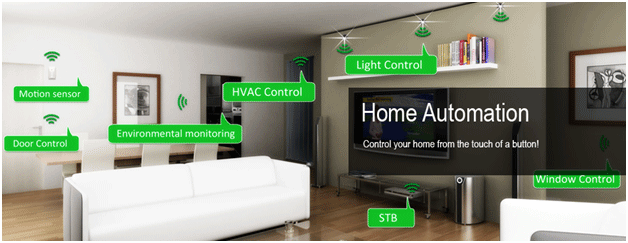The world around us is a constantly challenging environment and one needs be smart to overcome the challenges. The continually evolving technologies bring many opportunities for developers to successfully address the ever-evolving challenges. With the concept of home automation now coming into the picture, homes can now also be made smarter! ‘Home Automation’ as the name suggests means automation of the home and any house hold activity. As commonly said, it is an extension of building automation into residences, making life easier, comfortable and convenient for people, from a day to day perspective. That’s the reason why there is lot of buzz about home automation these days. In the initial phase, home automation was introduced as HVAC enabling Heating, Ventilating, Air Conditioning and Controlling. Additionally home automation can now also provide remote interface to appliances, all connected devices, as well as a central system to provide control and monitoring from a smart phone or tablet or a PC.
Most of the appliances that are available in the market today are already automated. We are already using washing machines, refrigerators, water heaters, thermostats, etc., which are automated to reduce manual work. Now imagine if these devices are able to talk to each other, exchange some data and take some decisions, how smart would that be?
Let’s discuss some popular use cases. Remote monitoring and surveillance in home automation could be triggered when say an intruder breaks the window of the house and the owner gets a call on his mobile phone or to an emergency number pre-programmed. Or, how about a home automation system making a shopping list for you every week end by monitoring (through bar code or RFID TAG) inventory of the products at home? Sounds awesome, isn’t it? Similarly, baby monitoring, video door bell, smart plugs, smart lights, etc. are some of other use cases.
With home automation, we are not only making the human life simpler and convenient but at the same time much more efficient, leading to money saving as well.
With the increase in the number of these controlled devices in homes, there will be challenges in terms of interconnection and communication, considering that these devices will be produced from worldwide manufactures in a variety of products belonging to different categories. Though lots of efforts have gone into creating certain standards, there are none perfectly defined as yet. Many systems are still utilizing the existing power circuits for communication by embedding the signals. There are number of other technologies like USB, ZigBee, Z-Wave, Bluetooth (BLE/BT), Wi-Fi, RFID and IP based 6LowPAN being used for inter communication. Home automation systems can use any of these technologies or combination of these standards with the use of protocol bridges.
Despite of so much of buzz and discussions taking place on home automation and related standards, the adoption and relevant use unfortunately, has still not reached a visible level. This is possibly because of the absence of any single communication standard, as discussed earlier. So the first and foremost hurdle to overcome is the single standard one which clearly defines the specifications on communication, hardware and software. Once this standard is in place, it should be supported with requisite platforms or groups encouraging an open source for software and open hardware, also allowing healthy competition and innovation to breed. However, the challenge on security, privacy breach and vulnerability still remain at large. Every now and then, an incident of hacking or data theft is reported from around the world, which is of a major concern. It is very important to address this challenge to be able to bring in a reliable, efficient model.
The government bodies, manufacturers, policy makers, standards organizations and the entire ecosystem have a major role to play here, to help provide infrastructure, standards, frameworks, etc.
 Let us have a look at the building blocks of a typical home automation system. Each home automation system usually includes the following types of devices:
Let us have a look at the building blocks of a typical home automation system. Each home automation system usually includes the following types of devices:
- Controllers – These can be a tablet, smartphone or a PC.
- Sensor – Devices which detect or measure a physical property and records, indicate, or otherwise respond to it.
- Actuators – These are type of motors that are responsible for moving or controlling a mechanism or system.
- Buses & Interfaces – These are used for wired or wireless communication links for machine to machine or human to machine interaction.
The driving factor for home automation is the need towards high-performing solutions for appliances used in safety, lighting, energy, entertainment and HVAC. As per Transparency Market Research, the Global Home Automation Market will be worth US$21.6 billion by 2020. This was earlier valued at US$4.41 billion in 2014.
Texas Instruments (TI) has a strategic commitment to the home/factory automation industry providing an extensive and reliable solution portfolio ranging from robust microcontrollers to ARM based microprocessors, complimented by a rich line-up of analog IC’s in power management, data converters, interfaces, wireless transceivers, amplifiers and industrial drivers. TI covers the entire solution space and allows automation equipment makers the flexibility to future-proof their products. Name what you need and TI has it. TI’s cutting-edge semiconductor process technology, coupled with its significant manufacturing capacity, allow it to offer products, like the harsh environment portfolio, which enables its customers to stay ahead of its competition.
Author:







